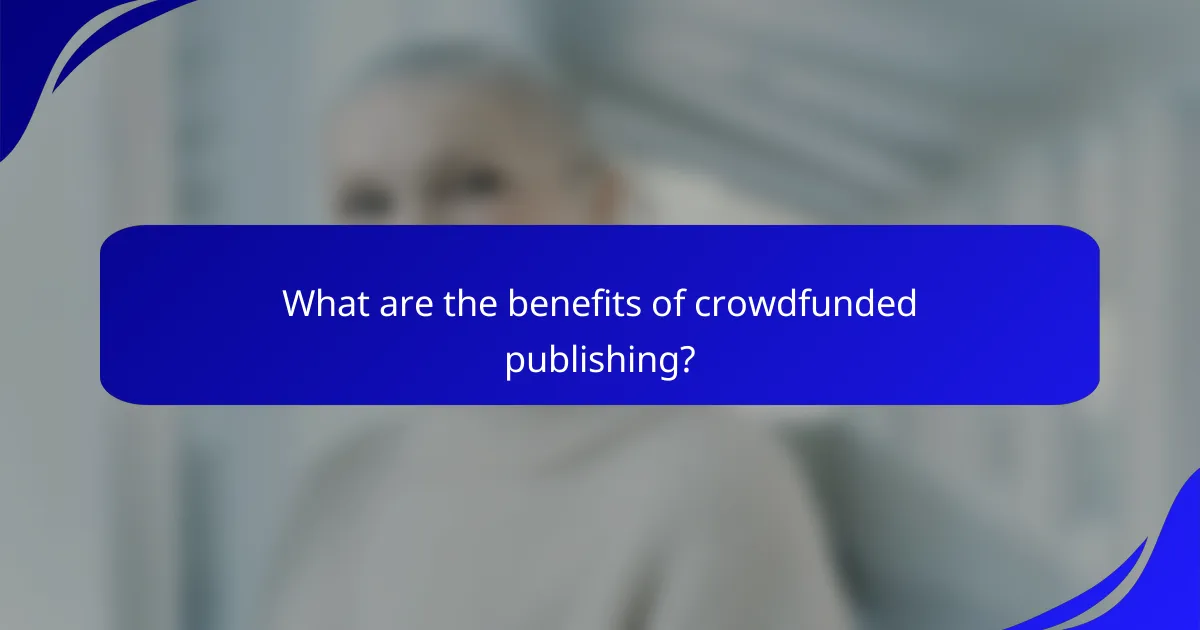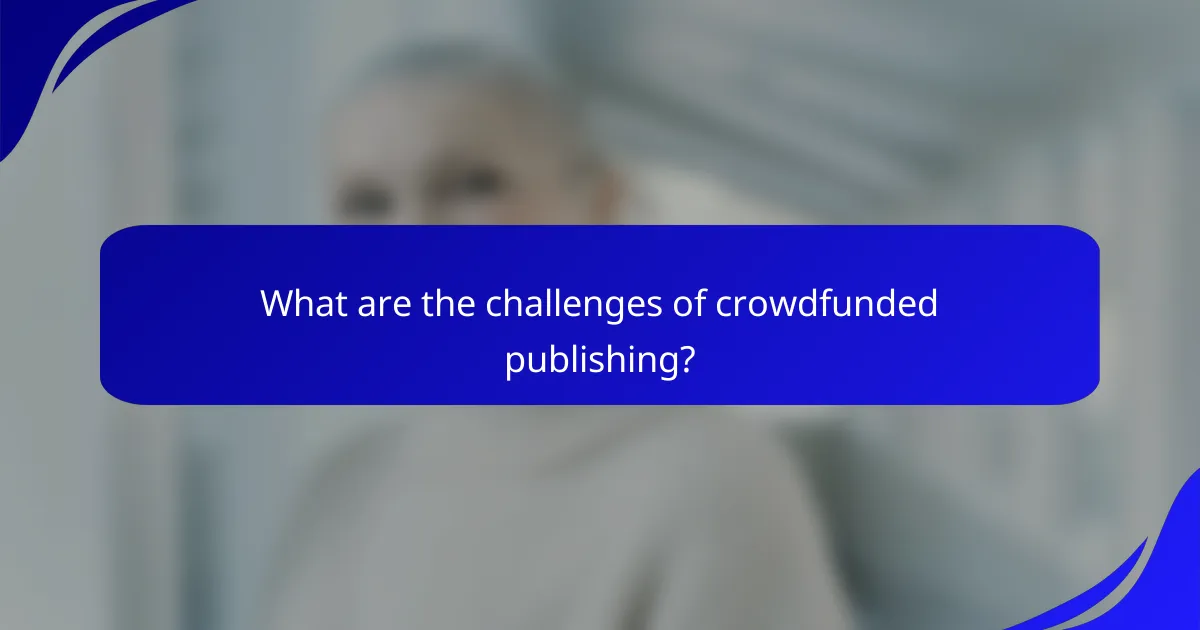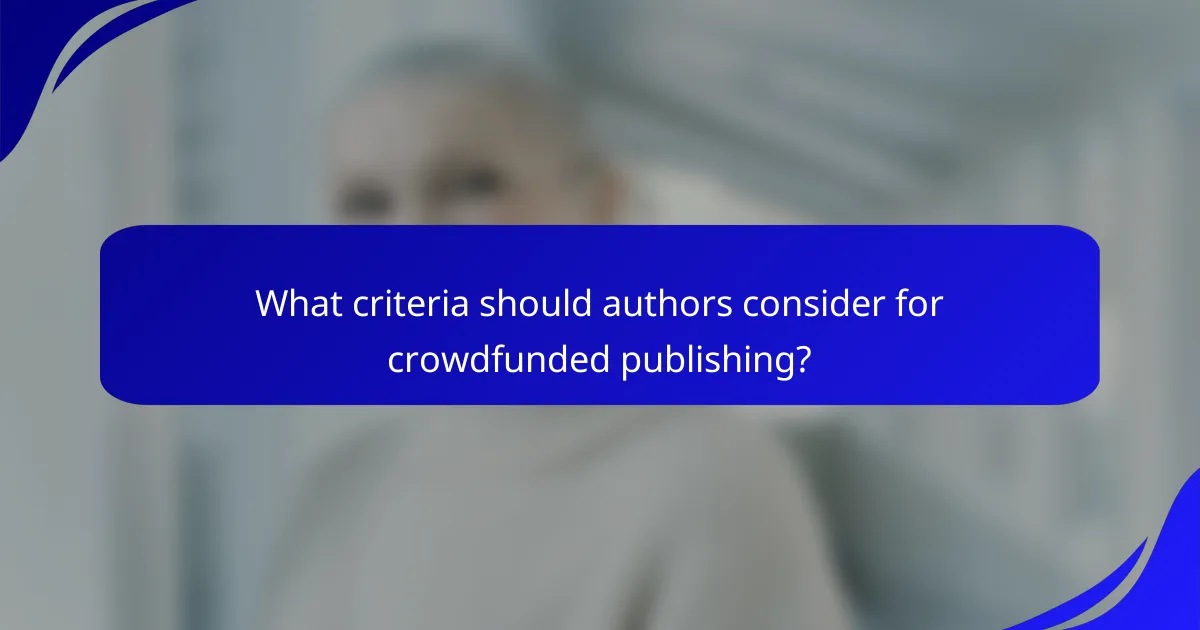Crowdfunded publishing is revolutionizing the way authors and publishers bring their projects to life by enabling them to seek financial support directly from their communities. This approach not only fosters enhanced reader engagement but also allows for the emergence of unique and innovative projects that might otherwise struggle for funding. By connecting creators with their audience, crowdfunded publishing cultivates a loyal base of supporters while ensuring that the interests of readers are prioritized.

How does crowdfunded publishing work in the UK?
Crowdfunded publishing in the UK involves authors or publishers seeking financial support from the community to produce books or other media. This model allows creators to gauge interest and secure funding before committing to production, often through platforms that facilitate direct contributions from readers.
Community-driven funding models
Community-driven funding models rely on collective financial support from individuals who believe in a project. Platforms like Kickstarter and Unbound enable creators to set funding goals and offer rewards, such as early access or exclusive content, to backers. This approach not only raises funds but also fosters a sense of ownership among supporters.
In the UK, successful campaigns often raise anywhere from a few hundred to several thousand pounds, depending on the project’s scope and appeal. Creators must clearly communicate their vision and engage with potential backers to build trust and excitement.
Reader engagement strategies
Effective reader engagement strategies are crucial for successful crowdfunded publishing. Creators can utilize social media, newsletters, and community events to connect with their audience and keep them informed about project developments. Regular updates and interactive content, such as polls or Q&A sessions, can enhance engagement and encourage more contributions.
Additionally, offering tiered rewards can motivate backers to contribute at higher levels. For instance, providing personalized acknowledgments or exclusive merchandise can create a more compelling reason for readers to support a project financially.
Unique project showcases
Crowdfunded publishing has led to a variety of unique projects that might not have found traditional funding. For example, niche genres, experimental formats, or culturally significant works often gain traction through community support. Projects like graphic novels, poetry collections, or specialized non-fiction can thrive in this environment.
Showcasing these unique projects not only highlights the diversity of content available but also inspires other creators to explore crowdfunding as a viable option. Successful examples can serve as case studies for future campaigns, illustrating the potential of community-backed publishing in the UK.

What are the benefits of crowdfunded publishing?
Crowdfunded publishing offers several advantages, including enhanced community support, increased reader engagement, and the opportunity for unique projects to thrive. This model allows authors to connect directly with their audience, securing funding while fostering a loyal reader base.
Increased reader involvement
Crowdfunded publishing encourages readers to take an active role in the creation process. By contributing financially, readers become stakeholders in the project, which often leads to greater investment in the content and its success.
This model allows authors to gather feedback and ideas directly from their audience, ensuring that the final product aligns closely with reader expectations. Engaged readers are more likely to share the project within their networks, amplifying its reach.
Diverse project opportunities
Crowdfunded publishing opens the door to a wide range of creative projects that traditional publishing might overlook. Authors can explore niche genres, experimental formats, or unconventional themes that resonate with specific audiences.
This diversity not only enriches the literary landscape but also allows authors to experiment without the constraints of mainstream market demands. Successful projects can lead to new trends and inspire other creators to pursue unique ideas.
Financial support for authors
Crowdfunding provides authors with essential financial backing to produce their work without relying solely on traditional publishing advances. This support can cover production costs, marketing, and distribution, enabling authors to maintain creative control.
Moreover, crowdfunding can create a more sustainable income model, as authors can gauge interest and secure funding before fully committing to a project. This approach minimizes financial risk and allows for better planning and execution of their work.

What platforms support crowdfunded publishing?
Several platforms facilitate crowdfunded publishing, enabling authors and creators to gather financial support from their communities. These platforms provide tools for engagement, project promotion, and funding management, making it easier for unique projects to come to life.
Kickstarter for authors
Kickstarter is a popular choice for authors seeking to fund specific projects, such as books or graphic novels. Creators set a funding goal and a deadline, offering rewards to backers based on their contribution levels. Successful campaigns often feature engaging videos and clear project descriptions to attract support.
Authors should consider the importance of marketing their Kickstarter campaign prior to launch. Building an audience through social media and email newsletters can significantly increase the chances of reaching funding goals. Common pitfalls include setting unrealistic funding targets or failing to communicate effectively with backers during the campaign.
Indiegogo publishing projects
Indiegogo offers flexible funding options, allowing authors to keep funds raised even if they do not meet their initial goals. This platform is suitable for a variety of publishing projects, including self-published books and literary magazines. Creators can choose between fixed and flexible funding models based on their needs.
When using Indiegogo, authors should focus on creating compelling project pages that highlight their vision and the impact of their work. Engaging potential backers through updates and community interaction can enhance support. Additionally, authors should be aware of the platform’s fees, which typically range from 4% to 9% of the funds raised.
Patreon for ongoing support
Patreon is designed for creators seeking continuous financial backing rather than one-time project funding. Authors can offer exclusive content, behind-the-scenes access, or early releases to subscribers who support them monthly. This model fosters a community around the author’s work and encourages sustained engagement.
To succeed on Patreon, authors should clearly define their tiers of support and the benefits associated with each level. Regularly updating patrons with new content and engaging them through polls or feedback can strengthen the relationship. It’s essential to maintain transparency about how funds are used to build trust and loyalty among supporters.

How to engage readers in crowdfunded projects?
Engaging readers in crowdfunded projects involves creating meaningful interactions that foster community support and investment. Effective strategies include leveraging social media, offering exclusive content, and organizing community events to build a loyal audience.
Utilizing social media
Social media platforms are essential for promoting crowdfunded projects and engaging with potential backers. By sharing updates, behind-the-scenes content, and interactive posts, creators can cultivate a sense of community and encourage participation.
Consider using platforms like Instagram, Twitter, and Facebook to reach diverse audiences. Regularly posting engaging content can increase visibility and drive traffic to your crowdfunding page.
Creating exclusive content
Offering exclusive content is a powerful way to incentivize reader engagement in crowdfunded projects. This could include early access to chapters, special artwork, or behind-the-scenes videos that are only available to backers.
Consider tiered rewards where higher contributions unlock more exclusive content. This not only motivates readers to pledge but also makes them feel valued and part of the project’s journey.
Hosting community events
Community events, whether virtual or in-person, can significantly enhance reader engagement. These events allow creators to connect directly with their audience, share insights, and gather feedback on their projects.
Examples include live Q&A sessions, workshops, or launch parties. Such gatherings can create excitement around the project and strengthen the bond between creators and their supporters, leading to increased funding and loyalty.

What are the challenges of crowdfunded publishing?
Crowdfunded publishing faces several challenges that can impact its success, including funding uncertainty, project visibility issues, and managing community expectations. Understanding these challenges is crucial for creators aiming to engage their audience and secure financial backing for unique projects.
Funding uncertainty
Funding uncertainty is a significant challenge in crowdfunded publishing, as projects often rely on the goodwill of backers to meet financial goals. Many campaigns may fall short of their targets, leading to incomplete projects or delays. Creators should set realistic funding goals and consider offering tiered rewards to incentivize contributions.
To mitigate risks, it’s advisable to conduct thorough market research before launching a campaign. This helps gauge potential interest and funding levels, allowing creators to adjust their strategies accordingly. A well-planned budget can also help in managing expectations around funding needs.
Project visibility issues
Project visibility issues can hinder the success of crowdfunded publishing efforts, as creators must compete for attention in a crowded marketplace. Without effective marketing strategies, even compelling projects may struggle to attract backers. Utilizing social media, email newsletters, and partnerships with influencers can enhance visibility.
Creators should also consider leveraging platforms that specialize in niche markets to reach targeted audiences. Engaging storytelling and high-quality visuals can further improve a project’s appeal and shareability, increasing the likelihood of funding success.
Managing community expectations
Managing community expectations is crucial for maintaining trust and engagement throughout the crowdfunding process. Backers often have high hopes for project outcomes and timelines, which can lead to disappointment if not properly addressed. Clear communication about project progress and potential delays is essential.
Creators should establish a transparent timeline and provide regular updates to backers. Setting realistic expectations regarding deliverables and timelines can help prevent misunderstandings and foster a supportive community. Additionally, being responsive to feedback can enhance backer loyalty and satisfaction.

What criteria should authors consider for crowdfunded publishing?
Authors should evaluate several key criteria for successful crowdfunded publishing, including understanding their target audience, assessing the feasibility of their project, and developing an effective marketing strategy. These elements are crucial for engaging readers and ensuring that the project meets its funding goals.
Target audience analysis
Identifying and understanding your target audience is essential for crowdfunded publishing. Authors should consider demographics such as age, interests, and reading habits to tailor their project effectively. Engaging with potential readers through surveys or social media can provide valuable insights into what they seek in a publication.
Additionally, analyzing similar projects can help gauge audience expectations and preferences. Look for successful campaigns in your genre to understand what resonates with readers and how you can differentiate your project.
Project feasibility assessment
Assessing project feasibility involves evaluating the resources needed to complete the publication and whether those resources can be realistically secured through crowdfunding. Consider factors such as budget, time frame, and the complexity of the project. A well-defined budget should include production costs, marketing expenses, and any potential rewards for backers.
Authors should also evaluate their own capabilities and availability to commit to the project. Setting a clear timeline with milestones can help manage expectations and keep the project on track.
Marketing strategy development
Developing a marketing strategy is vital for attracting backers to your crowdfunded project. Start by creating a compelling narrative around your work that highlights its unique aspects and benefits to potential readers. Utilize social media platforms, email newsletters, and author websites to generate buzz and build an audience before launching the campaign.
Consider offering tiered rewards for different levels of support, which can incentivize backers to contribute more. Regular updates during the campaign can also keep backers engaged and encourage them to share your project within their networks.
